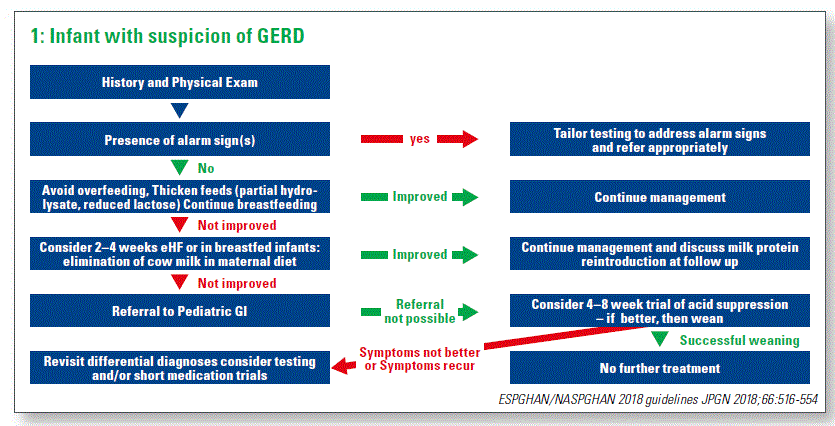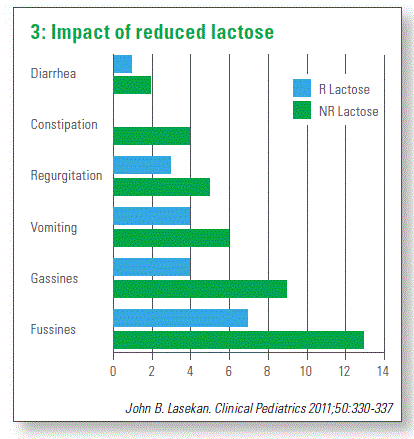The relevance of FGIDs in the daily pediatric practice
The relevance of FGIDs in the daily pediatric practice.
Yvan Vandenplas
FGIDs are very frequent. Indeed, for many of us, it’s one of the most common diagnoses of the patients that we see is that they suffer from FGIDs. I will focus on regurgitation, infant colic and constipation because they are definitely the most frequent.
According to data from France, up to 80% of the clinical visits in early life are due to gastrointestinal discomfort. Most of the time, patients present a combination of symptoms. And again, in these data from France gathered from questionnaires completed by 2,700 parents of infants, we observed that more than half of them, or more than three-quarters (78%) of the infants, were diagnosed with combined FGID- 63% presented 2 symptoms and that as much as 15% presented 3 or more symptoms (Bellaiche M 2018;107:1276). This is something that we should consider if we make guidelines (Chart 1).
A couple of years, ago a review of the literature tried to calculate how frequently FGID occurred and showed, according to 13 studies, that the median value is 25%, with extremes from 6% to 60%. We also sent out an email to 500 pediatricians world- wide asking them, “How frequently do you think that these problems occur your practice?” And the very subjective impression of those 500 colleagues was exactly the median value that we found in the literature: 25% of all the infants presented troubles involving regurgitation.
Regurgitation
We have no data at all that intervention decreases regurgitation at the age of 2–3 mo and will change the long term evolution. What we do know is that thickened formula is a very effective treatment for obvious regurgitation. The number of episodes of regurgitation decreased significantly. A study compared intact protein thickened with locust bean to partial hydrolysate thickened with low lactose. Statistically it was slightly better on this score, but whether or not this is clinically meaningful is a totally different question.
The only medication that we have to treat GI reflux disease (not regurgitation) is, of course, antacid-blocking medication.
Statements from another consensus paper try to find a definition of what that group of pediatricians, as key opinion leaders, considers to be troublesome regurgitation. We set >4 episodes, since > 2 wk in infants > 1 wk < 6 mo. Because regurgitation starts before the age of 1 wk, you have to be careful that it is not an anatomical problem. And regurgitation continues often >6 mo, but does not start after the age of 6 mo.
We also agreed that it was not an indication to do diagnostic investigations and that anti-regurgitation formula may be considered in infants with no troublesome regurgitation. Drug treatment is not indicated in physiological regurgitation and is also not indicated in troublesome regurgitation because there are no data of efficacy. And this is the algorithm according to the new ESPGHAN guidelines.
Infantile colic
Infantile colic is a challenge:
- it is very common with an incidence of 20–25%
- it has an impact on wellbeing and quality of life and it increases parental insecurity and anxiousness and also adversely affects parents’ social and emotional behavior
- it has a long term effect on functional gastro- intestinal disorders because there is a higher prevalence of FGID later in life.
Infantile colic is still a mysterious disorder of the microbial-gut-brain axis. There are a lot of factors which will influence colic, and more and more interest is focusing on the intestinal barrier function and the microbiome:
![]() - pathogenic bacteria such as enteropathogenic E. coli
- pathogenic bacteria such as enteropathogenic E. coli
- high-fat diet
- lipopolysaccharides (LPS)
- drugs such as non-steroidal anti-inflammatory drugs (NSAIDs) and PPIs
- various food allergens and the gluten component gliadin
And infantile colic is associated with gut microbiota and immunity. It is associated with dysbiosis, with increased gut sensitivity and causes low- grade systemic inflammation.

Compared with control group, colicky infants have slower colonization, lower diversity and stability. They express less butyrate-producing species, more proteobacteria (including species producing gas and inflammation) and also less lactobacilli and bifidobacteria (including species with anti-inflammatory effects). Escherichia coli are more abundant in the feces of infants with colic than in the feces of healthy infants.
In all children, during the first months of life, immaturity of the intestinal mucosa implies incomplete gut integrity, thus allowing the passage of large molecules into the bloodstream. Breastfed and formula-fed infants with infantile colic have an increased transmission of the macromolecule humana-lactalbumin across the gut compared with healthy age-matched infants. Fecal calprotectin levels were approximately 2-fold higher in infants with colic than in control infants.
Every functional gastrointestinal disorder is at least two times more frequent in infants with colic. When the pediatricians or the family doctors see an infant with colic, often that child also presents other FGID function prevalence (at least 2 or 3 times higher).
Pain-relieving agents for infants with colic have been shown to be not effective. The literature shows 2 interventions which may be effective: probiotic intervention, and you can try to have an active intervention with heat-killed probiotics together with a substance which decreases the permeability of the intestine (Chart 2).
Like a lot of our colleagues, we like to prescribe proton pump inhibitors (PPI) for crying babies. But there is no effect of PPI on crying and irritability in infants. However, 25% of the infants develop small bacterial overgrowth as a side-effect.
We also have consensus algorithm warning signs for infantile colic and organic symptoms of cow’s milk allergy reflux disease.
Functional constipation
The estimated prevalence of functional GI symptoms in infants < 12 months is 8–10% (median value).
A lot of treatment recommendations have been published. Partial hydrolysate, reduced lactose, prebiotics and palm-oil-free might be useful (Bongers ME. Nutr J. 2007 Apr 11; 6:8). High magnesium content has also been shown to be effective in infants with constipation (ChaoHC, Vandenplas Y. Nutrition 2007;23:469).
For probiotics for functional constipation, the lite- rature is divided in “yes” and “no,” but most of the time it is considered to be not particularly effective. Palm-oil-free formula might be effective in the management of infant constipation. But again focusing on reassurance and diet management.
Lactose
A few words about lactose because lactose is important as lactose in infant formula stimulates a healthy microbiota and stimulates the growth of lactobacilli; and with lactose-containing formula, you’ll get better absorption of calcium than with lactose-free formula. That is also illustrated in this slide, where you have better calcium absorption according to a higher calcium ingestion. And lactose plays an important role in the absorption of calcium. Yet on the other side, if you have reduced lactose in your formula, you have a significant decrease in many functional gastrointestinal symptoms. So the right balance is very important (Chart 3).


Conclusion
Functional GI disorders
- Time is the cure
- Reassurance!
- Dietary treatment
* Effective
* Safe
- Postpone medical treatment
- Breastfeeding is an unequalled way of providing idea food for the healthy growth and development of infants. (WHO, 2013)
